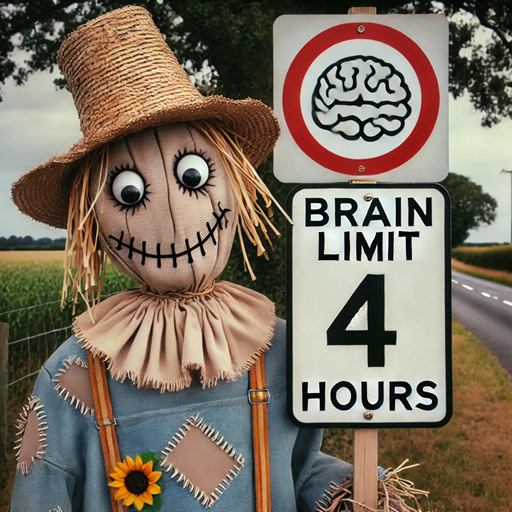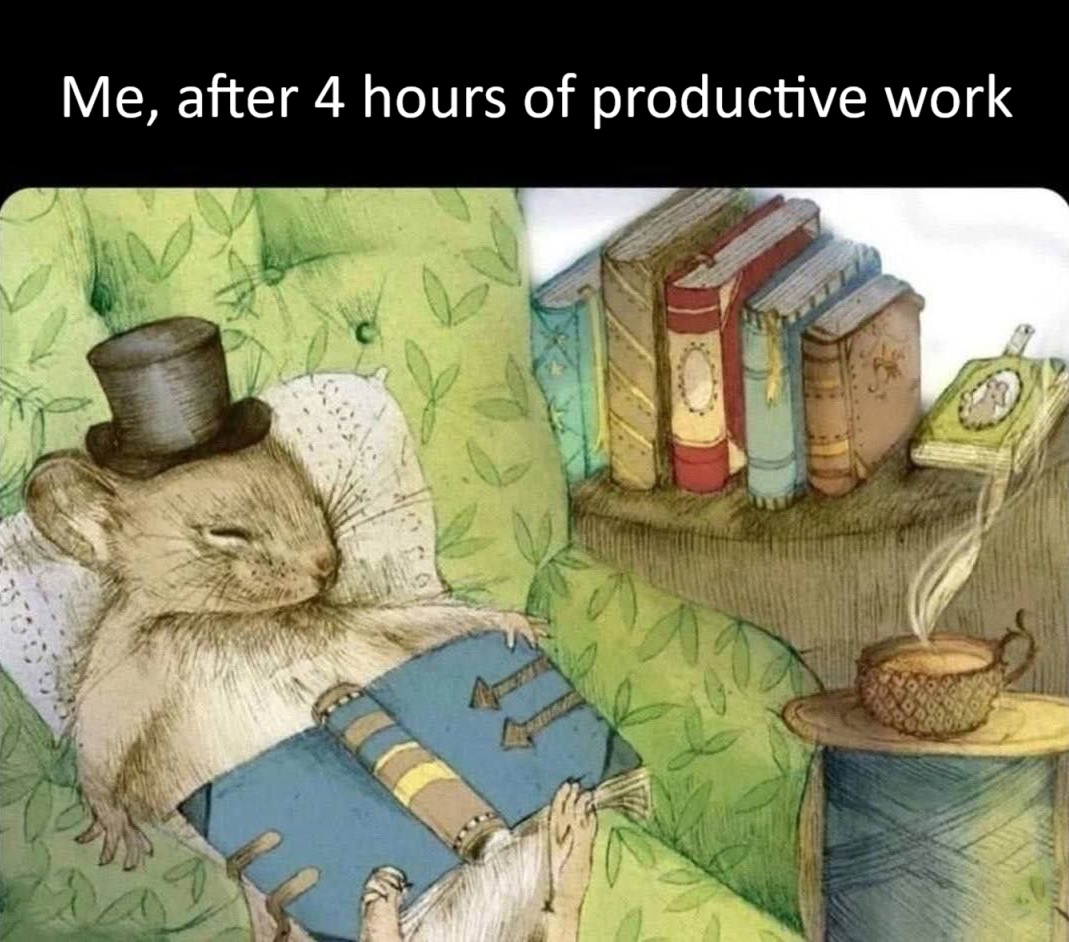4-Hour Workday
We can’t productively do creative work for more than 4 hours a day
In 2014, I graduated from university and got a job at a biotech company, where I was doing data science and developing data pipelines for large biological data (sequencing, specifically). There, I learned a lot about the way I personally work. For example, I noticed that I can work for a long time on simple tickets, similar to the tasks I learned at university. But working on large parts of the pipeline required creative efforts from me.1 And after 3-4 hours of such efforts, my productivity went to zero negative values. I could waste 2 hours trying to figure out why my code was running so slowly. The next morning, after sleeping,2 I would discover within 5 minutes that I was checking for the presence of a bunch of elements in a list instead of a set, a rookie mistake.
In the Wizard of Oz, there was a character called Scarecrow. He was smart, but he couldn’t think because he felt like his head was full of hay. “Hay-in-the-head” perfectly describes how I felt during these hours. So I call this invisible barrier at 4 hours of creative effort the “Scarecrow Limit”.

Last year, I started my own company to help R&D departments in Danish biotech and life science companies build useful software, pipelines, and infrastructure (contact me on LinkedIn if you have less than 150 people and your R&D’s IT is not up to par). I had no practical experience in B2B sales when I started the company. So, sales required my presence and creative efforts. And I immediately noticed the Scarecrow Limit again. I would start working on sales… and after 3-4 hours, my brain would switch off. After that, I could only write code.
Scarecrow Limit
My girlfriend had the same experience when she was writing her first book. She was writing a novel and teaching German at the same time. Writing a novel was a new experience and required a ton of creative effort. Teaching was a well-practiced and rehearsed process with thousands of hours of practice under her belt. She discovered that she had no problem working 8-12 hours a day… as long as she didn’t spend more than 4 hours per day writing. 4 hours of writing + 0 hours of teaching was good. 4+8 was great! But 6+0 was too much.
This is the first property of the Scarecrow Limit. After 4 hours of working on tasks that require creative effort, intellectual abilities decrease to zero.
The second property is that after crossing the Scarecrow Limit, time seems to accelerate. Before I reach that invisible barrier, I’m in the state of flow, and I can see 14,000,605 scenarios at once. I can solve everything, everywhere, all at once in 30 minutes. After I pass the Scarecrow Limit sign, I blink and 5 hours pass in an instant, to no avail.3
A Common Problem
(that we won’t acknowledge)
This is an uncomfortable idea. Imagine you are applying for a software engineer position, and you say that you get tired after writing fairly complex code for 4 hours. The interviewer will smile at you and say that they will call you back. In the software industry, we embrace a culture of “busyness.” We sell employers as many story points as possible per 100$ spent on salaries.
So, we learned to say that mental capability limits are an excuse. Yes, it happens that people cannot make creative efforts for more than 4 hours a day. But, look, it is all about ✨motivation✨! If people just enjoyed their work, they would have easily worked for 12 hours, like all these great minds who built Google and Apple and so on!
I don’t think that’s true. Surely, curiosity can provide energy and flow to put creative effort into your work. But I doubt anyone can actually make a creative effort for so long with a useful outcome. And it is not about motivation. I have a suspicion it is a biological limit.
The Perfect Job
Last August, I was lucky to join a writing retreat. Four of my friends who love to write fiction got together to peer-pressure each other to write.4 They are all experienced writers and write well. They came together to do what they love and find meaningful. In short, a dream job! They also only had 2 days, so they could focus as hard as they wanted, and they wanted to get as much work done as they could in such a short amount of time.
How many hours do you think we wrote per day?
And yet, everyone was completely exhausted, emotionally and physically, by the end of each day. Let that sink in, typing on a keyboard for 4 hours a day is physically exhausting.

The Aftermath
I am convinced that the Scarecrow Limit exists. Our brains are simply unable to sustain more than 4 hours of creative effort per day.
In most white-collar jobs, this means we cannot work more than 4 hours a day at all. Let’s imagine that all routine work will be automated out by computers and the ongoing rapid advance of AI. What happens next? I’m a techno-optimist, and our folk say that it will be great. Because instead of doing drudgery, automation will free us to be awesomely creative. It’s hard for me to say if that will ever happen. But imagine we do achieve what we’ve been promised. What if we, Scarecrows, are left to do nothing but creative work, and still have to work 8 hours a day? How insanely overloaded will we become?
And by the way, what does that say about me and you, reader? Sure, we are doing 8 hours of creative irreplaceable work, and we wouldn’t tell anyone otherwise.5 But… If science6 and personal anecdotes across 11 years show that it is impossible, then what are we actually doing? You and I might think we are special, creative snowflakes. But it seems like at least half of our work is either a routine or a “Bullshit Job”. No matter how white our collar is. After all,
Feeling an existential crisis yet?
Like my writing? Subscribe to me on Substack to get an email every time I post an essay.
Important! When I say “creative efforts”, I don’t mean “creative jobs” (artists, musicians, etc.). Every job has a mundane component and a creative component mixed in some proportion. “Creative effort” is when my brain can’t blindly reuse an existing solution and has to “create” something new to get the job done. ↩︎
A 30-minute nap after lunch helps a lot to reload my creative abilities. So I started sleeping every day to restore my “productive creativity” ever since I was at university. To be honest, I never understood how people could fare without sleeping during the day, but apparently that’s a thing… ↩︎
10 years later, I went on paternity leave with my first child, and I experienced the same time shrinkage. Every day, from 8 am to noon, I was very focused. From noon to 4 pm, I was doing ok. Then I blinked at 4 pm, and it was 8 pm and time to go to bed. ↩︎
Kind of the “Shut Up and Write” format, extended to cover the entire day. ↩︎
Gosh, I had to slap myself so many times while writing this post, and it still ended up being a LinkedIn ad, so I had to fully rewrite it. If you think that writing “yeah, I can’t work more than 4 hours a day creatively” is easy, then why don’t you leave me this comment on my LinkedIn post, where everyone can see it? ;-) ↩︎
I don’t discuss it here in detail, but, for example, Rutger Bregman, in his book “Utopia for Realists”, cites research showing that we can’t work more than 6 hours a day, altogether, creatively or not. ↩︎